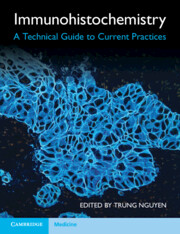Book contents
- Immunohistochemistry
- Immunohistochemistry
- Copyright page
- Dedication
- Contents
- Contributors
- Preface
- Chapter 1 Immunohistochemistry Fundamentals
- Chapter 2 Immunohistochemistry Quality Assurance and Quality Control
- Chapter 3 Automation and Robotics with the Leica Bond III
- Chapter 4 Automation and Robotics with the Roche Ventana BenchMark ULTRA
- Chapter 5 Automation and Robotics with the Agilent Dako Omnis
- Chapter 6 Immunohistochemistry for Research Applications
- Chapter 7 Troubleshooting Immunohistochemistry
- Chapter 8 Current Status of Immunohistochemistry
- Chapter 9 Immunohistochemistry for Future Applications
- Index
- References
Chapter 1 - Immunohistochemistry Fundamentals
Published online by Cambridge University Press: 16 June 2022
- Immunohistochemistry
- Immunohistochemistry
- Copyright page
- Dedication
- Contents
- Contributors
- Preface
- Chapter 1 Immunohistochemistry Fundamentals
- Chapter 2 Immunohistochemistry Quality Assurance and Quality Control
- Chapter 3 Automation and Robotics with the Leica Bond III
- Chapter 4 Automation and Robotics with the Roche Ventana BenchMark ULTRA
- Chapter 5 Automation and Robotics with the Agilent Dako Omnis
- Chapter 6 Immunohistochemistry for Research Applications
- Chapter 7 Troubleshooting Immunohistochemistry
- Chapter 8 Current Status of Immunohistochemistry
- Chapter 9 Immunohistochemistry for Future Applications
- Index
- References
Summary
The immunohistochemistry assay has evolved over many years. Primarily based on an antibody binding to epitopes in tissue sections, the technology has come a long way from its earliest manifestation using direct fluorescence labels. Current polymer technology is the result of many variations and adaptations on technique throughout the years. Indeed, much of its continued development is owed to early pioneers who experimented and overcame technical boundaries. This chapter is a broad discussion about what immunohistochemistry is from the historical perspective, and the individuals who have contributed to its expansion. It includes a journey about protocol adaptations and explanations of their context and applications. This chapter provides a sound basis in which to explore the rest of the book.
- Type
- Chapter
- Information
- ImmunohistochemistryA Technical Guide to Current Practices, pp. 1 - 23Publisher: Cambridge University PressPrint publication year: 2022
References
- 1
- Cited by



